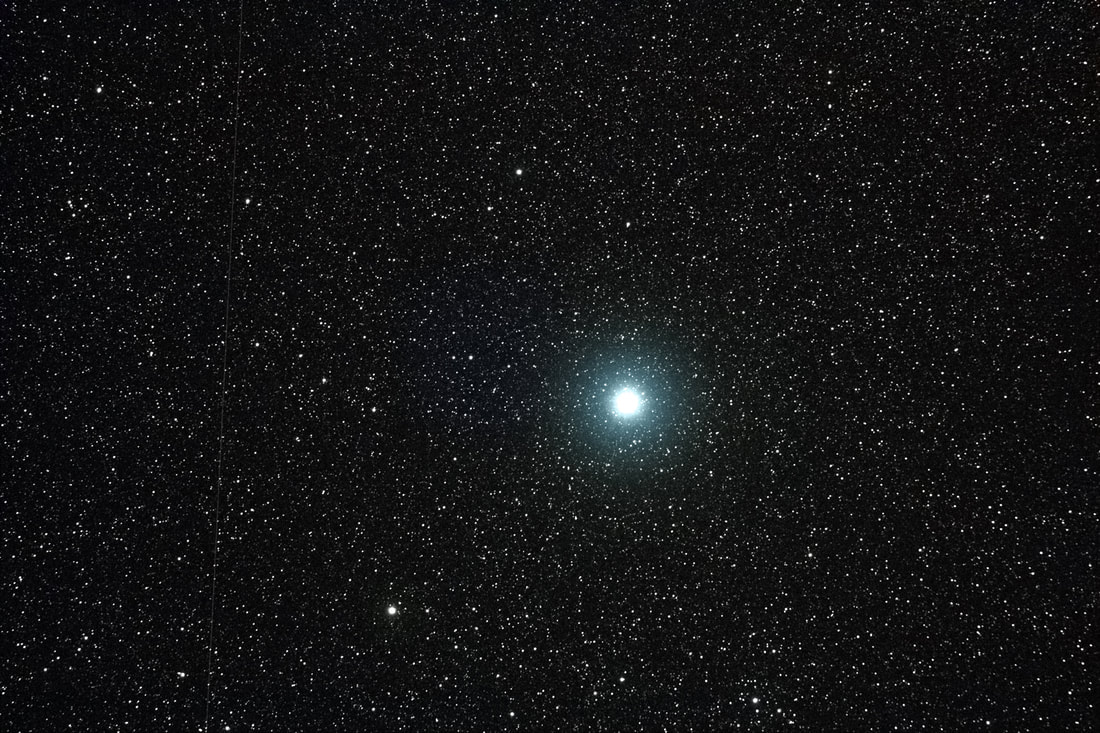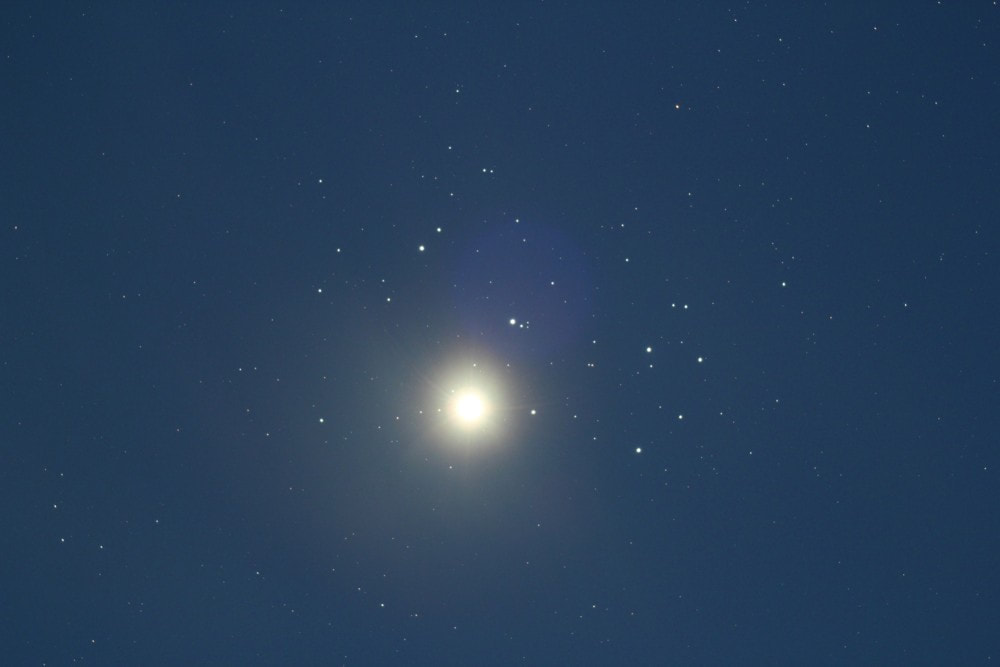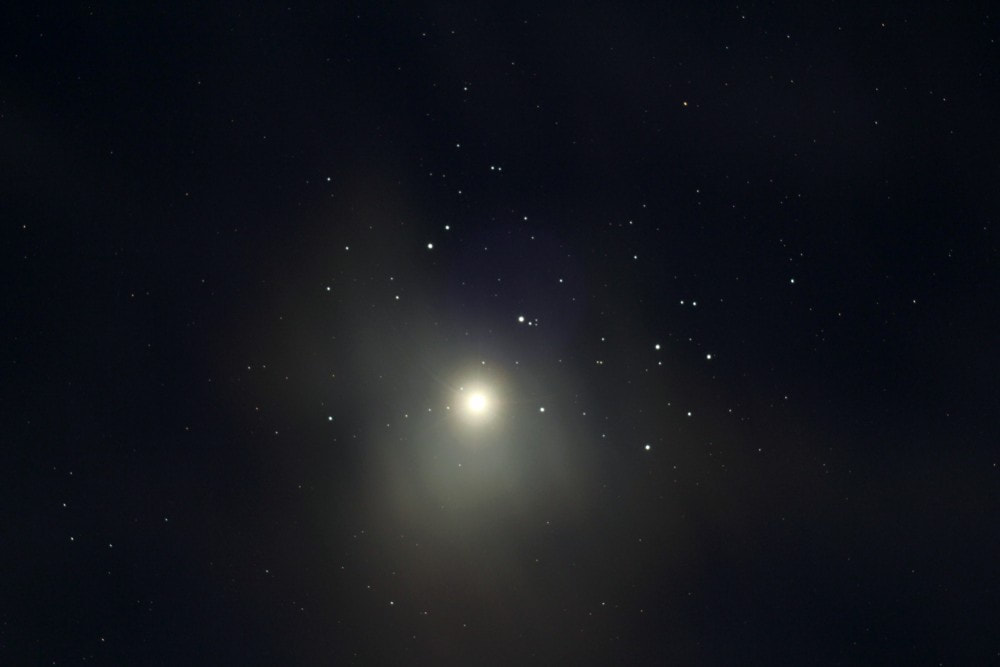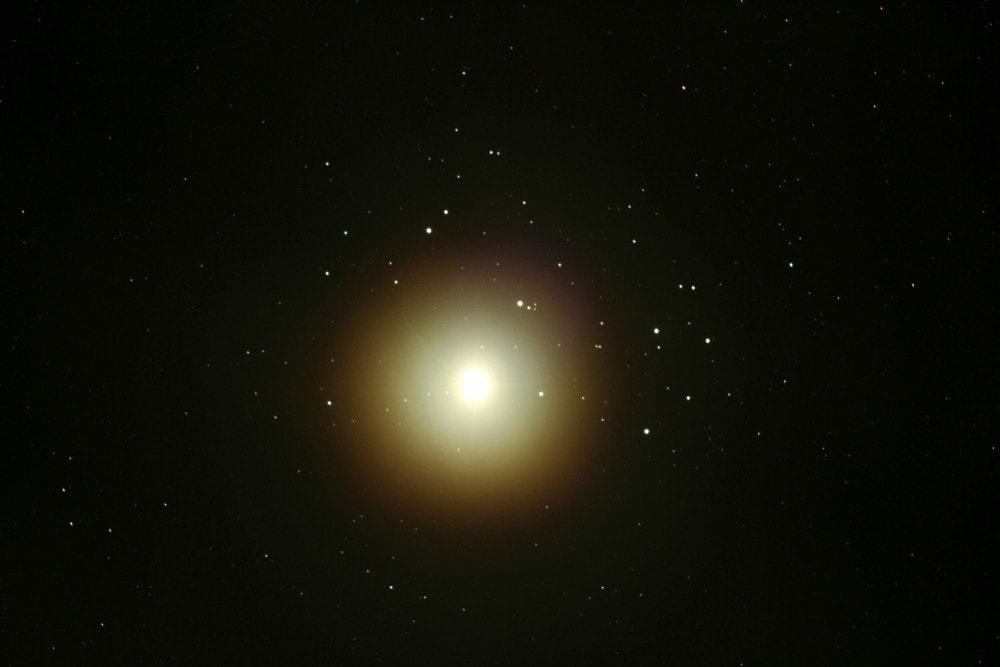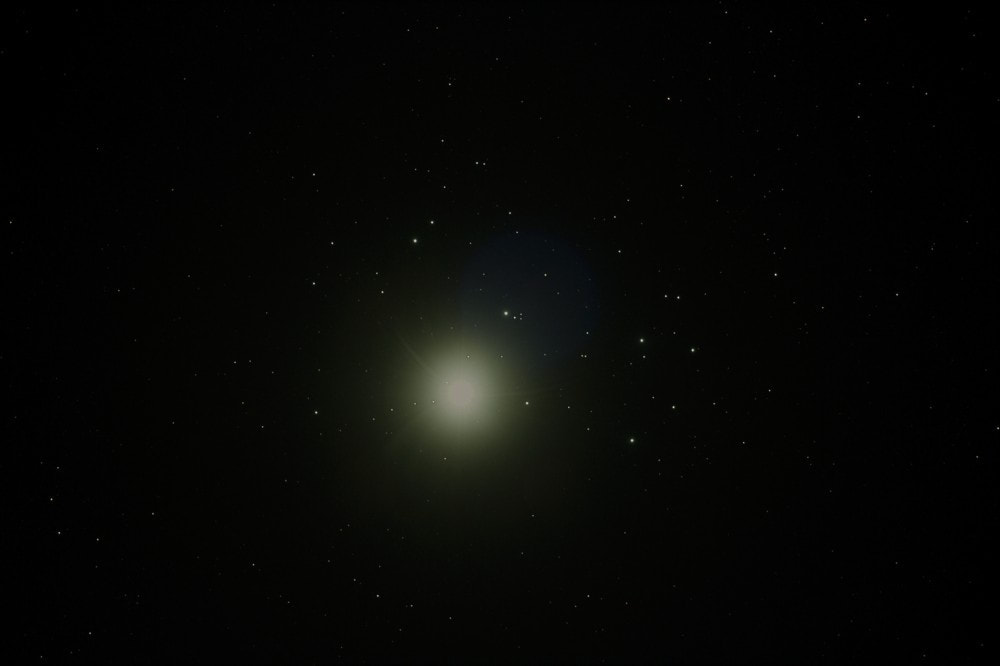Altair, image taken in 2018 by Andrew Atterbury.
Andy says
Aquila the Eagle, which has the brightest star in that constellation, called Altair (alpha Aquilae) ; whose name is derived from both Arabic and then Latin; meaning bird. This star forms part of the famous Summer Triangle with Deneb and Vega. The term Summer Triangle is something Patrick Moore on a Sky at Night programme introduced to his viewers.
I have attached Altair image I took last year in North Wales. This was an extremely dark sight and is a one shot image taken with a Canon 60DA camera fitted to the rich field William Optics Telescope. Visually when I took this, Altair seemed to be surrounded by a slight mist, and this has picked up in the image. This is some high thin cloud in our atmosphere, scattering the light of Altair. From a really dark site you will see this sort of thing and Venus can cast shadows from a dark location. I have witnessed this too. On the cloudy nights at this Welsh location, which was most of them, you could not see the clouds visually, as there is virtually no light pollution there. From most locations in Britain we are still wasting lots of energy to light up the sky, so that we can see the clouds at night.
There is a line crossing the left hand side of the image. The exposure was, I think, about 20 seconds, so it is likely this is an artificial satellite crossing the field.
Astro-imagers are often accused of only trying to capture the faintest things in the sky possible, and that I think is very true, and this is always a challenge if you have lots of light pollution where you live, and some give up without trying to image anything else in the sky because they could not capture something faint, when they could have been imaging much brighter and easier targets to capture in the sky. Altair was an easy one to capture and it is surrounded by lots of stars in the field. It is an interesting area of the sky, and you rarely see this type of image, because there is no faint nebula to capture in the field. Really, it looks crowded from our perspective, but in reality the stars are really distant from each other and all at different distances from us.
Aquila’s, Altair is close by Stellar standards; just 16 light years distant, and is an amazing first magnitude star; as it spins extremely quickly on its axis and completes one revolution on its axis in 6 and a half hours. This high rate of spin causes the poles to flatten and causes it to bulge out at the equator. We see a similar thing with Jupiter; which is also fluid in nature; and it is flattened at its poles because it spins so fast, but not so dramatically distorted as the star; Altair. The equatorial diameter of Altair, because of this fast spin, is much greater than its the polar diameter, so it would have an elliptical appearance if you could see Altair close up. Altair is flanked on either side by 2 stars Gamma and Beta Aquilae, which makes it easy to locate in the Summer Sky. Anyway, Aquila is something to look forward to when the Eagle next returns to our evening skies during this Summer.
Andy says
Aquila the Eagle, which has the brightest star in that constellation, called Altair (alpha Aquilae) ; whose name is derived from both Arabic and then Latin; meaning bird. This star forms part of the famous Summer Triangle with Deneb and Vega. The term Summer Triangle is something Patrick Moore on a Sky at Night programme introduced to his viewers.
I have attached Altair image I took last year in North Wales. This was an extremely dark sight and is a one shot image taken with a Canon 60DA camera fitted to the rich field William Optics Telescope. Visually when I took this, Altair seemed to be surrounded by a slight mist, and this has picked up in the image. This is some high thin cloud in our atmosphere, scattering the light of Altair. From a really dark site you will see this sort of thing and Venus can cast shadows from a dark location. I have witnessed this too. On the cloudy nights at this Welsh location, which was most of them, you could not see the clouds visually, as there is virtually no light pollution there. From most locations in Britain we are still wasting lots of energy to light up the sky, so that we can see the clouds at night.
There is a line crossing the left hand side of the image. The exposure was, I think, about 20 seconds, so it is likely this is an artificial satellite crossing the field.
Astro-imagers are often accused of only trying to capture the faintest things in the sky possible, and that I think is very true, and this is always a challenge if you have lots of light pollution where you live, and some give up without trying to image anything else in the sky because they could not capture something faint, when they could have been imaging much brighter and easier targets to capture in the sky. Altair was an easy one to capture and it is surrounded by lots of stars in the field. It is an interesting area of the sky, and you rarely see this type of image, because there is no faint nebula to capture in the field. Really, it looks crowded from our perspective, but in reality the stars are really distant from each other and all at different distances from us.
Aquila’s, Altair is close by Stellar standards; just 16 light years distant, and is an amazing first magnitude star; as it spins extremely quickly on its axis and completes one revolution on its axis in 6 and a half hours. This high rate of spin causes the poles to flatten and causes it to bulge out at the equator. We see a similar thing with Jupiter; which is also fluid in nature; and it is flattened at its poles because it spins so fast, but not so dramatically distorted as the star; Altair. The equatorial diameter of Altair, because of this fast spin, is much greater than its the polar diameter, so it would have an elliptical appearance if you could see Altair close up. Altair is flanked on either side by 2 stars Gamma and Beta Aquilae, which makes it easy to locate in the Summer Sky. Anyway, Aquila is something to look forward to when the Eagle next returns to our evening skies during this Summer.
4 images of the recent conjunction between Venus and the Pleiades taken by Andrew Atterbury on April 3 2020.
Andy says
"These were taken using the William Optics 81mm F/5.6 APO refactor, using HEQ 5 Sky watcher equatorial mount.
Camera was the Canon 60DA and ISO setting was usually 800. Some are composite stacked images, some are one shot.
There was high cirrus cloud at the time and I have even got a Venus halo. Adds to interest in this case."
Andy says
"These were taken using the William Optics 81mm F/5.6 APO refactor, using HEQ 5 Sky watcher equatorial mount.
Camera was the Canon 60DA and ISO setting was usually 800. Some are composite stacked images, some are one shot.
There was high cirrus cloud at the time and I have even got a Venus halo. Adds to interest in this case."
